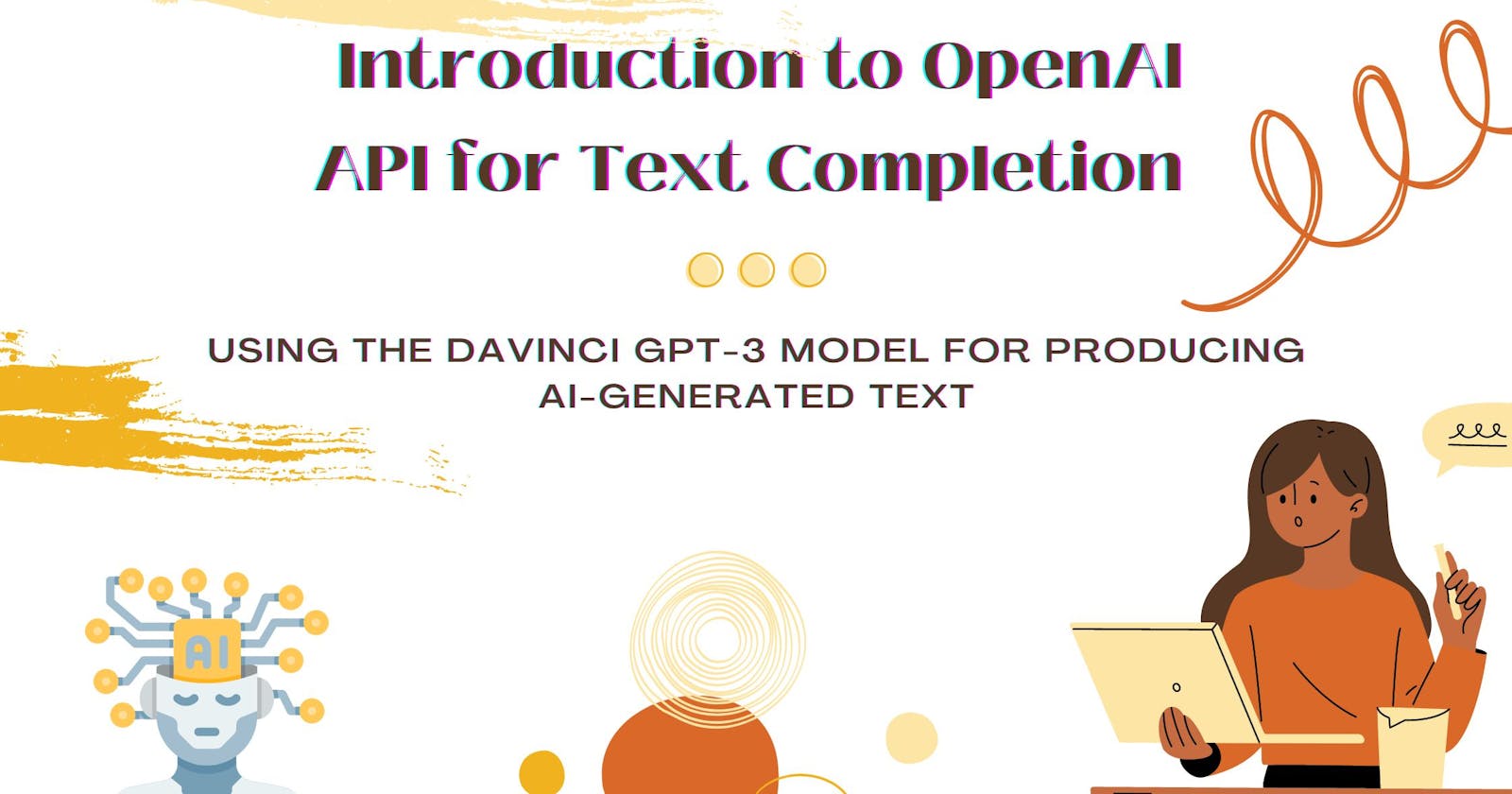Introduction to OpenAI API for Text Completion
Using the Davinci GPT-3 Model for producing AI-Generated Text
This article was written with support from AI.
It showcases how you can leverage OpenAI's API for Text Completion to take your projects to the next level. With the rising popularity of ChatGPT and other AI-related technologies, it's more important than ever to dive into the capabilities of this powerful tool.
The objective of the article is to highlight the basics of OpenAI's API for Text Completion, and how it functions to generate and manipulate text with the use of OpenAI models.
What is OpenAI API? 😟
OpenAI is a research company that develops and promotes friendly AI in the hopes of benefiting humanity as a whole. It also provides a platform for training, deploying, and experimenting with AI models. The OpenAI API is a set of programming tools and services that allow developers to use OpenAI's pre-trained models to perform various natural language processing tasks such as text generation, language translation, and text completion. It enables developers to easily integrate AI functionality into their own applications and services.

Using OpenAI API for Text Completion
The OpenAI API for Text Completion can be used to generate text based on a given prompt or context. This can help to reduce the amount of time and effort required to write or code by providing suggestions and completing text automatically. The API utilizes OpenAI's pre-trained models to generate human-like text which can be used to improve language and grammar in writing, provide code suggestions in programming and even complete entire documents. It's a powerful tool for both personal and professional use.
OpenAI API for Text Completion Models
The OpenAI API for Text Completion provides access to a variety of pre-trained models that can be used for natural language generation tasks. These models have been trained on a large corpus of text data, allowing them to generate human-like text based on a given prompt or context. The models are fine-tuned to improve the overall quality of the generated text. The API allows developers to access these models through a simple API endpoint, allowing them to easily integrate text generation functionality into their applications.
GPT-3 as an OpenAI API Base Model 💥
GPT-3, or Generative Pre-trained Transformer 3, is an advanced language processing model developed by OpenAI. It can be used as a base model for various natural language tasks such as text generation, language translation, and text summarization.
GPT-3 is a part of the OpenAI API, which allows developers to access the model's capabilities through an API call. The API also includes four main models under GPT-3:
"Davinci" is the most advanced model in the GPT-3 suite. It is capable of writing essays, poetry, and even computer code.
"Curie" is designed for answering questions and providing information. It can be used for chatbot applications, information retrieval, and other tasks that require understanding and responding to natural language.
"Babbage" is optimized for working with structured data, such as tables and lists. It can be used for data extraction, data cleaning, and other data-related tasks.
"Einstein" is designed for working with numerical and scientific data. It can be used for tasks such as equation solving, data analysis, and data visualization.
All of these models are pre-trained on a massive amount of data and can be fine-tuned for specific tasks, which makes it very useful for developers and researchers to leverage the power of AI in their projects.

Davinci Model 🔥
The OpenAI API's Davinci model for text completion is a powerful tool for natural language generation tasks that utilize the GPT-3 language model. It is fine-tuned to generate text that is similar to that written by humans. This model can be used for various use cases such as writing creative fiction, composing poetry, generating chatbot responses and even composing emails, it can also help in coding by providing suggestions for code completion. The Davinci model is known for its high quality and human-like text generation capabilities.
The prompt is the text that you give to the Davinci model as input. The model will then generate text based on the given prompt. You can use this to generate text that is similar to the given prompt or to complete the prompt in a way that makes sense.
Tokens are a way of measuring the amount of text generated by the Davinci model. Each token represents a single word or punctuation mark. You can specify the number of tokens you want the model to generate, and the model will generate that many words or punctuation marks.
The OpenAI API has different versions of the Davinci model, each with its own set of parameters and capabilities. You can specify which version you want to use when making a request to the API. Additionally, you can specify other query parameters such as temperature, top_p and top_k for fine-tuning the text generated.
Using the Davinci Model for Text Completion
To use the OpenAI API's Davinci model for text completion, you will first need to sign up for an API key on the OpenAI website. Once you have your API key, you can use it to make requests to the API endpoint for the DaVinci model.
A simple way to make a request to the API is to use the requests library in Python. Here is an example of how to use the requests library to complete a text using the DaVinci model:
import requests
api_key = "your_api_key_here"
model = "text-davinci-002"
prompt = "Once upon a time, in a land far far away"
response = requests.post(
"https://api.openai.com/v1/engines/{}/completions".format(model),
headers={"Authorization": "Bearer {}".format(api_key)},
json={
"prompt": prompt,
"max_tokens": 100,
}
)
completed_text = response.json()["choices"][0]["text"]
print(completed_text)
This will return the completed text generated by the Davinci model based on the prompt given.

It is important to note that you will have to replace "your_api_key_here" in the code sample with your own API key, and you can modify the prompt to your desired input.
Remember to create a virtual environment and install the requests library in it in order to run this code snippet.
Using Prompts in the Davinci Model

In the OpenAI API's Davinci model for text completion, a prompt is a piece of text that serves as a starting point for the model to generate new text. The prompt can be any text you want the model to complete or continue. The model uses the prompt as a context to create new text that is similar in style and content to the prompt.
For example, if you want the model to generate a story, you might provide a prompt like "Once upon a time, in a land far far away" and the model will generate text that continues the story.
When making a request to the API, you can include the prompt as a string in the prompt field of the JSON object in the request body. The API will then use this prompt to generate new text.
It is important to note that the length of the prompt and the generated text can be adjusted using the max_tokens parameter, which limits the number of tokens (words or word-like units) in the generated text.
You can also use multiple prompts separated by | in the prompt field to generate more complex and specific text.
Using Tokens in the Davinci Model
In the OpenAI API's Davinci model for text completion, a token is a word or word-like unit that the model uses to generate text. Tokens are the basic building blocks of the text generated by the model. Tokens are similar to words in natural language and are used to represent the text in a way that the model can understand.
The Davinci model uses a neural network to generate text by predicting the next token in the text given the previous tokens. It uses the input prompt as context and based on that, it will generate the next token that fits the context.
When making a request to the API, you can use the max_tokens parameter to limit the number of tokens in the generated text. This can be useful if you want to generate shorter or longer text.
It's important to note that the token count can also affect the quality and coherence of the generated text, too many tokens may result in a long text that may not make sense and too few tokens may result in a text that is not detailed or complete.
Using the Davinci Model for Text Completion in a Flask App 🎊
Using the OpenAI API's Davinci model for text completion is relatively simple and can be done using a few lines of code. Here's an example of how to use the model in a basic Flask app to generate text based on a given prompt:
from flask import Flask, request, jsonify
import openai
app = Flask(__name__)
openai.api_key = "YOUR_API_KEY"
@app.route('/generate', methods=['POST'])
def generate():
data = request.get_json()
prompt = data['prompt']
completions = openai.Completion.create(
engine="text-davinci-002",
prompt=prompt,
max_tokens=100,
n=1,
stop=None,
temperature=0.5,
)
text = completions.choices[0].text
return jsonify({'generated_text': text})
if __name__ == '__main__':
app.run(debug=True)
In this example, a Flask app is created and an endpoint /generate is defined. It accepts a POST request with a JSON object containing the prompt field. The openai library is used to make a request to the OpenAI API with the specified prompt, engine, token count and other parameters. The generated text is then returned in the response as a JSON object with a generated_text field.

The above code is just a basic example, you can add more functionalities to the code as you get familiar with the OpenAI API and the model.
In order to run this code, you will need to have the flask and openai python packages installed and also you need to provide your own API key, which you can get by signing up on the OpenAI website.
Further Reading 💌
OpenAI API documentation: beta.openai.com/docs/api-reference/introduc..
OpenAI API quickstart guide: beta.openai.com/docs/guides/quickstart
OpenAI API beginner-friendly projects: beta.openai.com/docs/guides/projects
OpenAI API Davinci model for text completion: beta.openai.com/docs/models/davinci
Conclusion 🎓
The OpenAI API for Text Completion is a powerful tool that allows developers to easily integrate AI functionality into their own applications and services. It utilizes OpenAI's pre-trained models to generate human-like text based on a given prompt or context. The DaVinci model is a particularly powerful option, fine-tuned to generate text that is similar to that written by humans. It can be used for various use cases such as writing creative fiction, composing poetry, generating chatbot responses and even composing emails.
Next Steps 👻
Like and share if this was useful to you.
Drop your comments, feedback and/or suggestions in the comment section.

